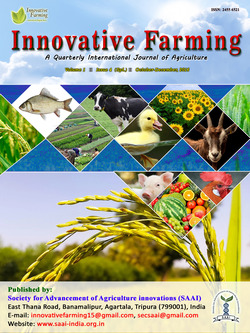
Managing Boron and Zinc Deficiency in Vegetable Crops
Subhrajyoti Chatterjee*
Department of Vegetable Science, Faculty of Horticulture, Bidhan Chandra Krishi Viswavidyalaya, Mohanpur, Nadia, West Bengal-741252, INDIA
Debmala Mukherjee
Department of Vegetable Science, Faculty of Horticulture, Bidhan Chandra Krishi Viswavidyalaya, Mohanpur, Nadia, West Bengal-741252, INDIA
Shweta Sharma
Department of Vegetable Science, College of Horticulture, Dr YS Parmar University of Horticulture and Forestry, Nauni, Solan, Himachal Pradesh-173230, INDIA
Partha Choudhuri
Department of Vegetable Science, Faculty of Horticulture, Bidhan Chandra Krishi Viswavidyalaya, Mohanpur, Nadia, West Bengal-741252, INDIA
DOI: NIL
Keywords: vegetables, boron, zinc, deficiency, management
Abstract
Among the horticultural crops, vegetables have an important position and are considered as ‘protective food’. In recent past the production of vegetables has gone up due to adoption of modern technologies and fertilizer formulation but still productivity is much less than world average. One of the major causes of such situation is the indiscriminate use of major nutrients and giving less importance on micronutrients which are very much necessary for quality vegetable production. Boron and Zinc are the two most important micronutrients which are deficient in soils of several countries of the world including India. Analysis of soil and plant samples has indicated that 49% of soils in India are potentially deficient in Zn and 33% in boron. Crops grown in about half of the country’s soils suffer from one or more micronutrient deficiency disorders. The deficiency of these two micronutrients drastically affects the yield and quality of vegetables. So prevention or correction of B and Zn deficiency in crops on deficient soils can have a dramatic effect on yield and quality of vegetables. Selection of proper fertilizer source, application at appropriate rate, using correct formulation, right method of application, timely application and proper balancing of B and Zn micronutrients with other nutrients in soil are some strategies which leads towards more yield and quality production of vegetables. Both soil and foliar application methods of boron and zinc are effective in improving yield and quality of produce.
Downloads
not found
Reference
Das, S.K., R.K. Avasthe, R. Singh and S. Babu. 2014. Biochar as carbon negative in carbon credit under changing climate. Current Science, 107: 1090-1091.
Das, S.K., R.K. Avasthe and A. Yadav. 2017. Secondary and micronutrients: deficiency symptoms and management in organic farming. Innovative Farming, 2(4): 209-211.
Shivay, Y.S. 2013. Zinc: vital to crop production and productivity. Kurukshetra, 62(1): 44-48.
Singh, M.V. 1991. Micronutrient management in rice-wheat cropping system. In. Proceeding of rice-wheat, PDCSR, Modipuram, pp. 133-144.
Singh, M.V. 2001. Evaluation of micronutrient stocks in different agroecological zones of India. Indian Journal of Fertilizers, 46: 25-42.
Singh, M.V. 2006. Micronutrients in crops and in soils of India. In. Micronutrients for global crop production, (Eds.) Alloway, B.J. Springer, United Kingdom, pp. 93-125.
Takkar, P.N., S.K. Mehta and I.M. Chibba. 1990. A decade of micronutrient research. In: Research Bulletin, AICRP Micronutrient, IISS, Bhopal, pp. 1-136.
Tiwari, K.N. and R. Tiwari. 2015. Managing boron deficiency in vegetable crops. Indian Horticulture. 60(1): 16-19.
Vitosh, M.L., D.D. Warncke and R.E. Lucal. 1994. Secondary and micronutrients for vegetables and field crops. Michigan State University. pp: 10-12.
